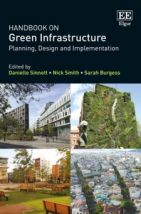Handbook on Green Infrastructure: Planning, Design, and Implementation

Seen as a valuable resource for cities and towns, green infrastructure holds the “potential to mitigate many of the challenges facing urban environments, including biodiversity loss, environmental degradation and health inequalities”, as well as adaptation to climate change and food security challenges (page 1). In the Handbook on Green Infrastructure: Planning, Design, and Implementation, editors Danielle Sinnett, Nick Smith and Sarah Burgess bring together the work of 47 academics and practitioners to set the context for green infrastructure and provide guidance on establishing it.
This handbook is organized into five parts. These progress from looking at the role of green infrastructure in the urban environment (Part 1) to strategic planning (Part 2), design (Part 3), and implementation and management (Part 4), before concluding (Part 5).
Part 1 follows a brief introduction by the editors and outlines “the historical and thematic development of green infrastructure as a planning process” (page 105). Chapter 1 explores how green infrastructure influences health and well-being, drawing on a case study of the Greenlink cycle path in Scotland. Chapter 2 focuses on the benefits of urban vegetation to positively impact air quality and temperature. Chapter 3 examines how green infrastructure can contribute to sustainable urban water management, using the example of the SuDS treatment train in Stroud, England. Chapter 4 is intended to help green infrastructure practitioners to make well-informed decisions about economic valuation. And Chapter 5 discusses biodiversity in cities and what characteristics can be prioritized in green infrastructure to enhance it.
Part 2 begins with Chapter 6, which presents green infrastructure policy from the USA and Europe to illustrate current debates within policy-making and delivery, as well as from India and China to show developing policy opportunities. Chapter 7 looks at the emergence of green infrastructure and explores its journey in the Mersey Forest in north-west England. Chapter 8 explores practices in Cambridge, UK and Cambridge, USA (page 145), and in Chapter 9 the case of Óbidos, Portugal is used to explore the application of the European Land Convention’s principles and land quality objectives for the strategic planning of green infrastructure. Understanding green infrastructure “as a system of socio-ecological elements”, Chapter 10 presents a methodology for identifying and selecting these elements in the process of planning green infrastructure in metropolitan landscapes (page 186). Chapter 11 then presents an approach to ensuring green infrastructure for all.
Part 3 turns towards design and in Chapter 12 begins by outlining a green infrastructure typology for urban environments. Chapter 13 promotes an inclusive approach to the design of green infrastructure, and argues that “the design of green spaces and the public realm has disadvantaged disabled” and other vulnerable people (page 242). In Chapter 14 the use of public open spaces is investigated in relation to the design and quality of their surrounding neighbourhoods. Chapter 15 investigates how school grounds and city parks can be designed to serve intergenerational needs. Chapter 16 outlines how green infrastructure can contribute to a sense of place in historic urban environments, while Chapter 17 describes two cases in Portugal and Italy to demonstrate how green and grey infrastructures can be reconciled.
In Part 4, Chapter 18 details three models of public green space governance; discusses the role of partnership in managing public green spaces; and considers funding, skills and management as key aspects of governance. Chapter 19 explores the concept and practice of community involvement in green infrastructure, while Chapter 20 assesses the implementation of green infrastructure in the UK’s residential development, namely speculative housing provision. Chapter 21 then investigates the potential for green infrastructure in urban brownfield regeneration. And Chapter 22 “presents the use of logic models in the development and implementation of a monitoring and evaluation programme” for green infrastructure (page 415).
In conclusion, Part 5 discusses the future of urban green infrastructure, conceding that it “will inevitably flex according to changes in economic, social and environmental conditions” (page 445). Chapter 23 thus looks at the nature of evolving cities, changing urban demographics, the future-proofed city in response to climate change, and finally the new opportunities at hand for green infrastructure.
Book note prepared by Hannah Keren Lee
Search the Book notes database
Our Book notes database contains details and summaries of all the publications included in Book notes since 1993 - with details on how to obtain/download.
Use the search form above, or visit the Book notes landing page for more options and latest content.
For a searchable database for papers in Environment and Urbanization, go to http://eau.sagepub.com/

